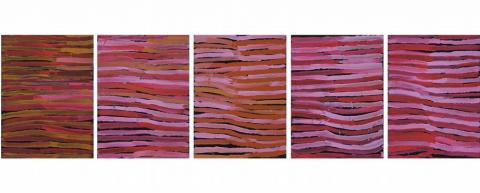BODY PAINT, 1993
EMILY KAME KNGWARREYE
synthetic polymer paint on canvas (5)
121.5 x 91.5 cm (each)
121.5 x 457.5 cm (overall)
inscribed verso: artist's name
Commissioned by Rodney Gooch, Alice Springs
Martin Browne Fine Art, Sydney
Private collection, NSW
It is difficult to think of another Australian artist who, having started painting so late in life, left such an enduring mark on modern Australian art- and with this multi panelled work we can begin to understand why. It marks a departure from her first paintings where the patterns and dots represent the wellspring of her experience, namely her Alhalkere home at Utopia in the Eastern Desert, north east of Alice Springs and her representation of the landscape and its cycles, the seasons, her Dreamings.
With the introduction of the lineal forms of body designs and scarification marks, she takes a new direction in her work. As a young woman embarking upon her ritual education, she learnt about awelye designs while painting on the bodies of women about to take part in a ceremony. Awelye refers to the ceremonial world of women, or women's business, and includes women's ceremonial body designs. The striped design painted on the breasts and neckline of ceremonial dancers seems to be the inspirational starting point for many of Kngwarreye's paintings. She had used lines before and then gradually submerged them under skeins of dots. Now she presented the art world with simple, bold compositions of parallel lines in strong dark colours. Body Paint 1993 is a masterwork of strength and simplicity, reflecting the journey of the line in her work. Horizontal, parallel, thin, thick, dark, light, smooth, jagged all relating back to simple ritual designs painted on the body.
Emily's career began in the late 1980s, and in the years until her death in 1996, she produced a body of work which radically altered the way in which we see and understand modern Aboriginal art. For most of her life she lived with little contact with the outside world. While much can be made of the way in which we view her work in parallel with modern, non-indigenous abstraction, we must first recognize her achievement as a truly inventive and original contributor to Aboriginal art.
